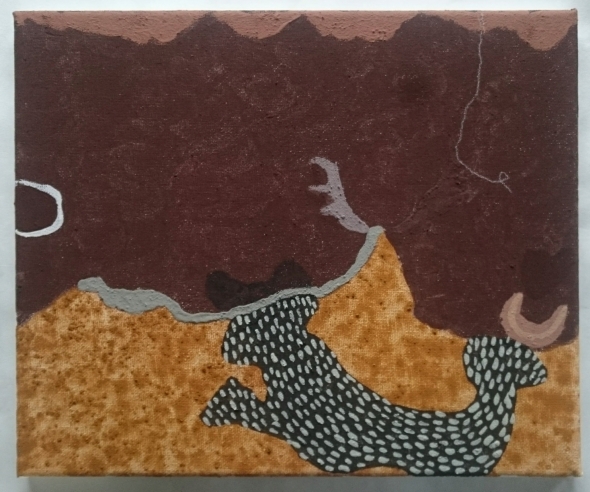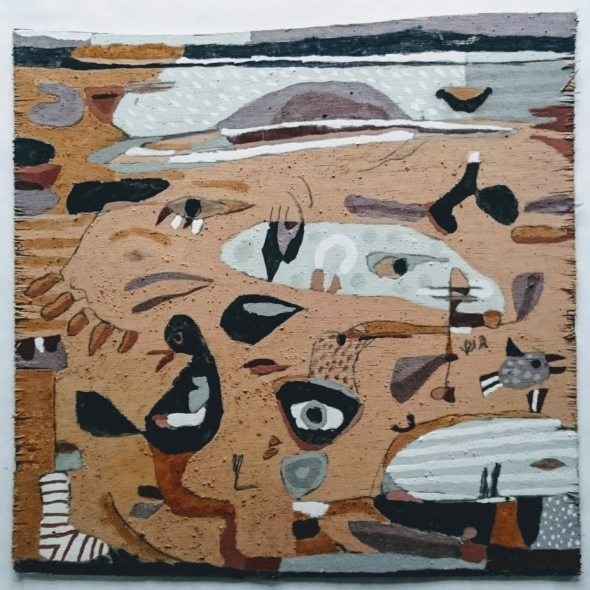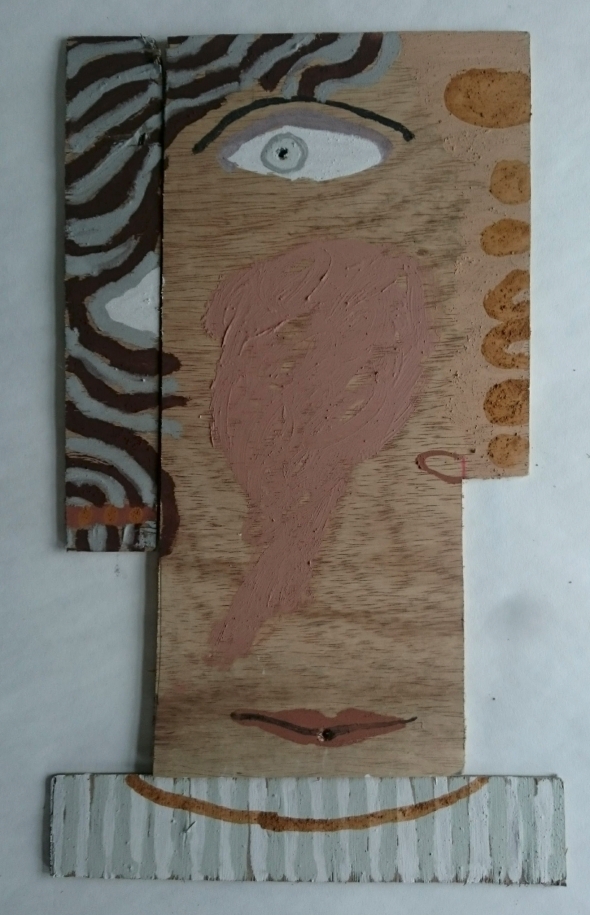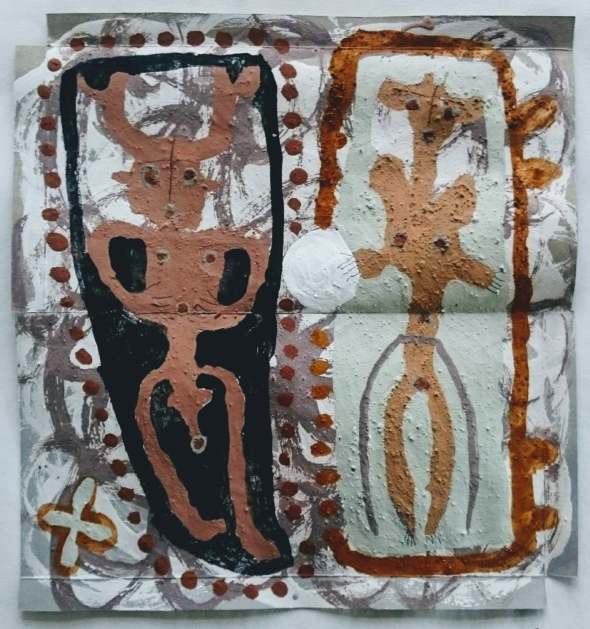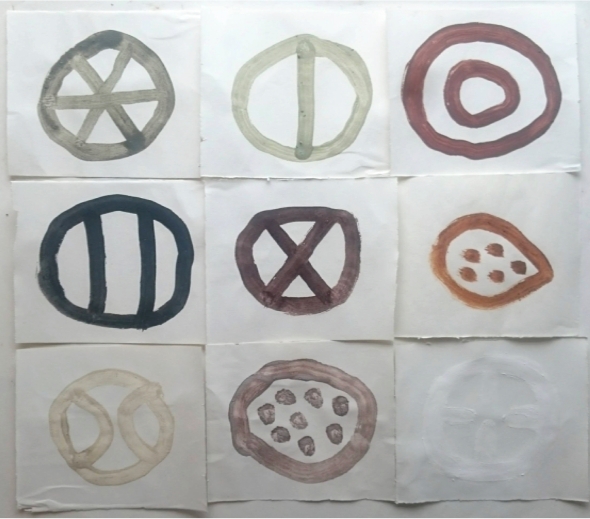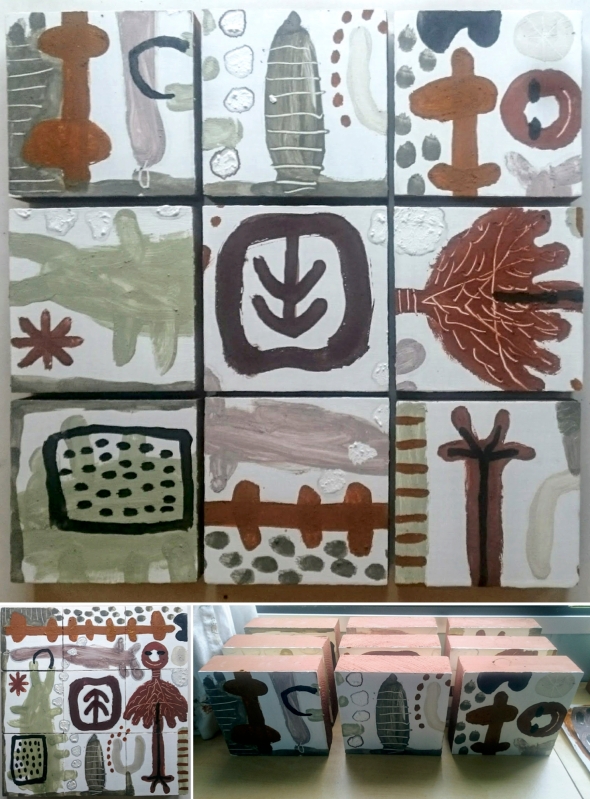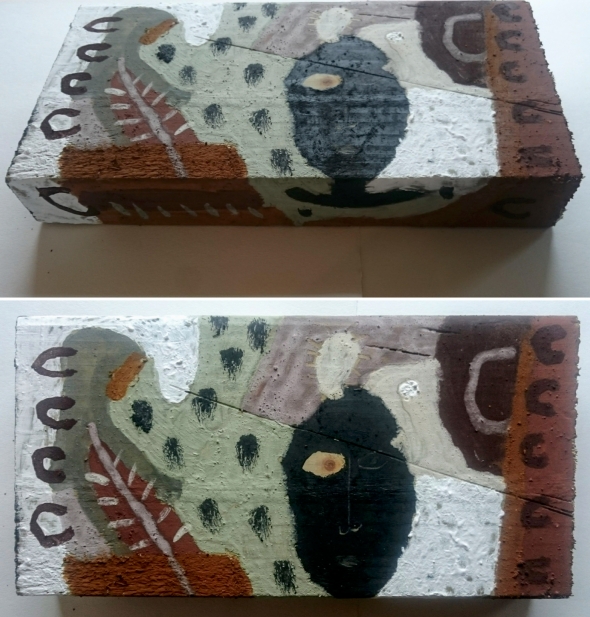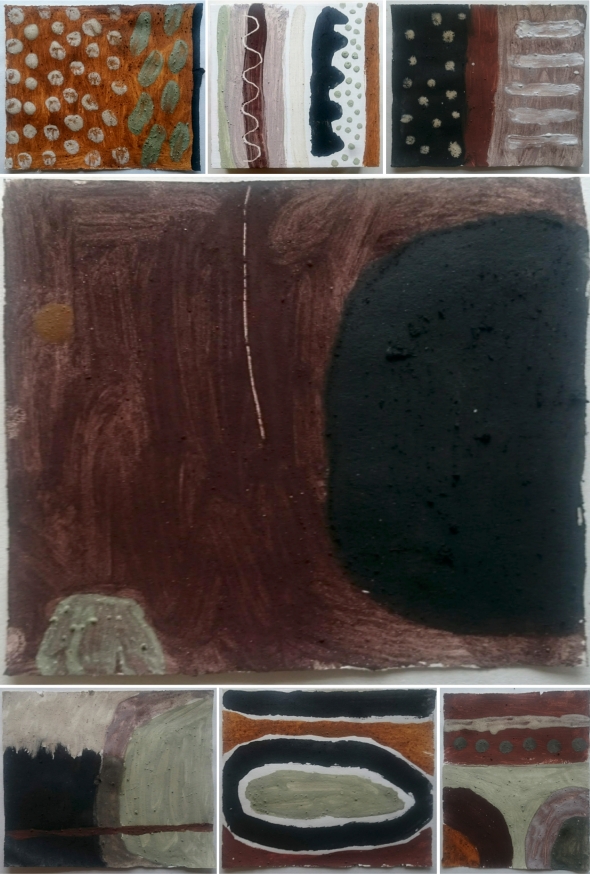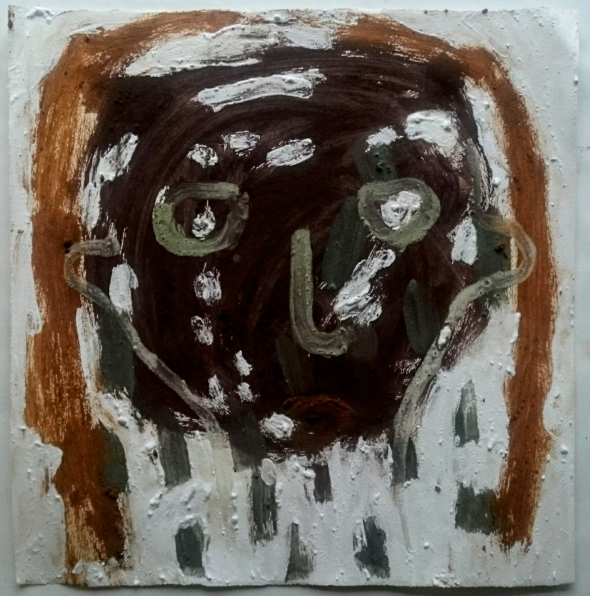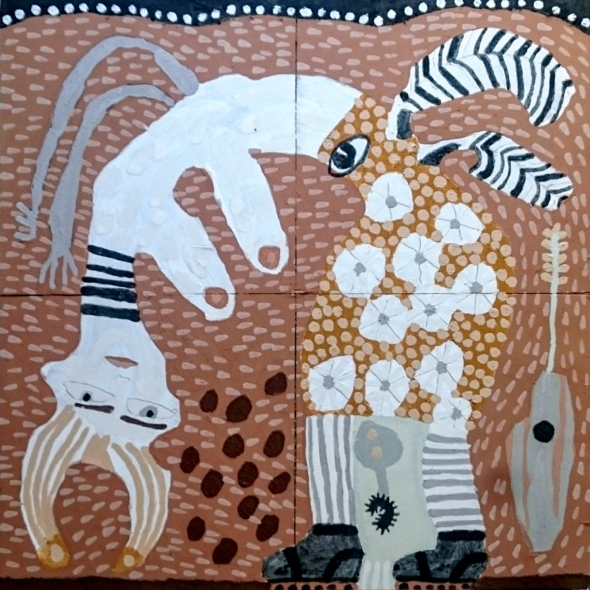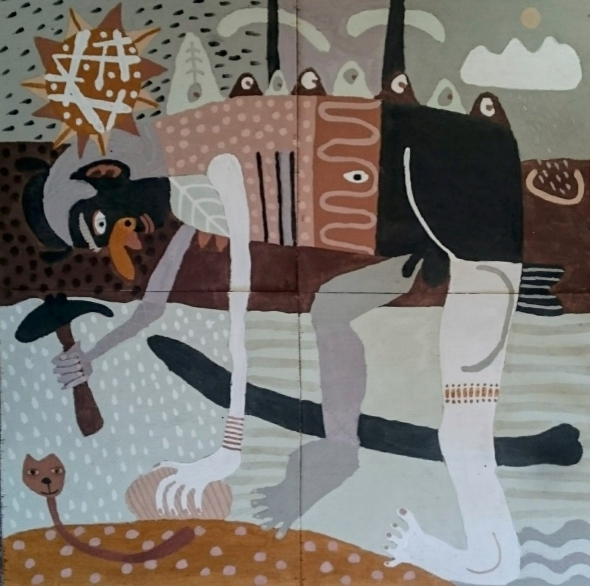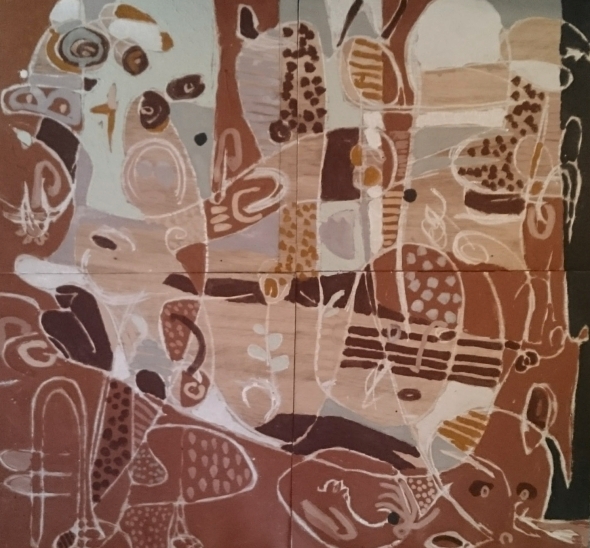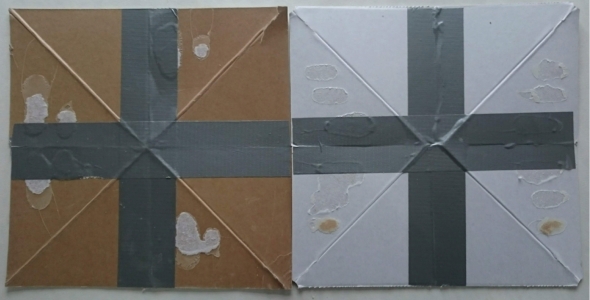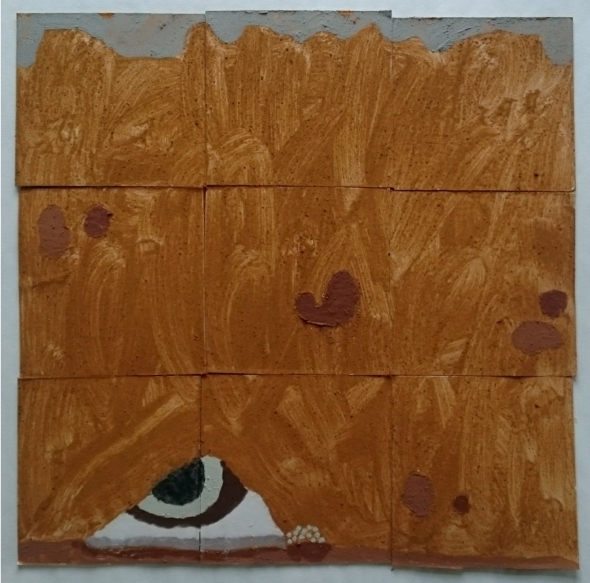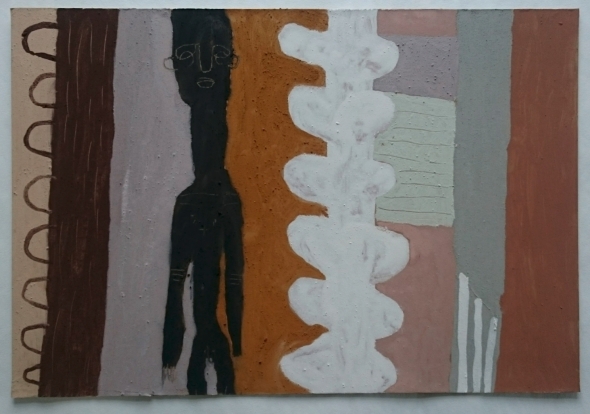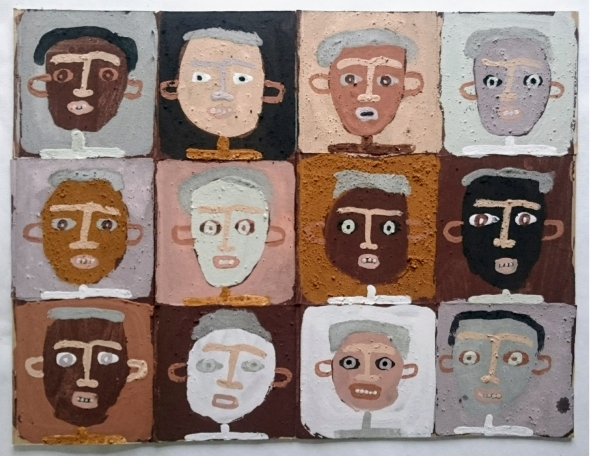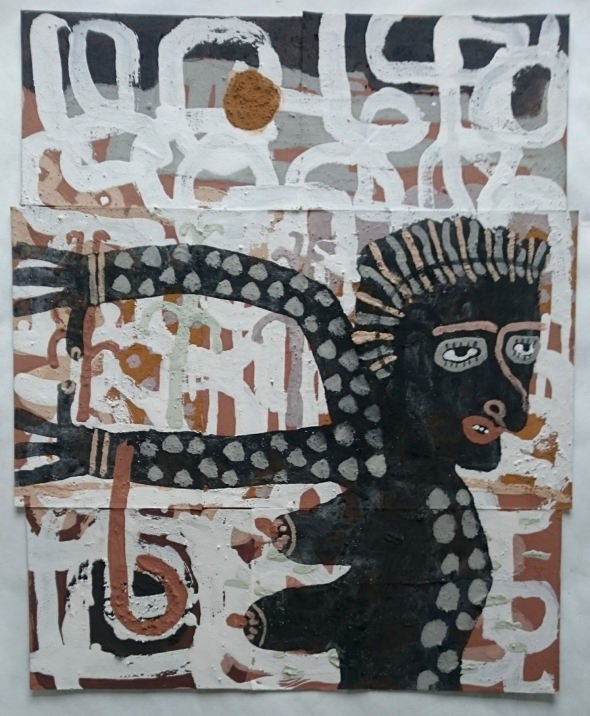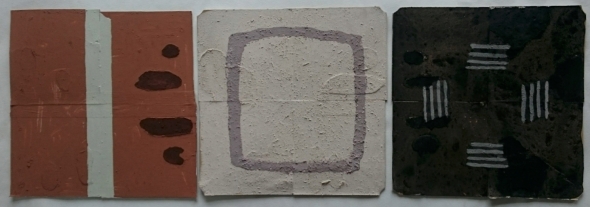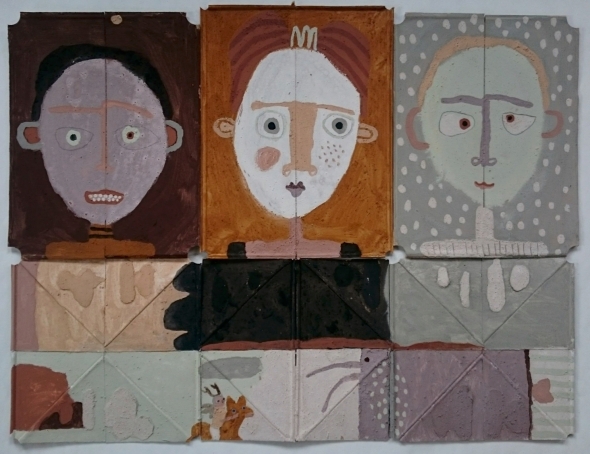no light no colour no more
Posted: February 25, 2019 Filed under: eARTh | Tags: Aesthetics, art and science, Arte Povera, Arts, arts research, Cornwall, earth pigments, eco art, ecopsychology, Environmental art, Feeling, indigenous culture, painting, Pigment, Visual arts 2 Commentsfurther material responses to existential emergence, crisis and change
I was reminded recently, while gazing fleetingly into the shimmering turquoise green blue ocean here in West Cornwall, of my early art training based in the classical understanding of colour. colour as light. a systematic mixing together of homogenous materials to represent the colours that we observe in Nature from a set of ‘primaries’: reds, blues and yellows. no black. white in moderation. of hue.
 iron board, Praa Sands, Cornwall (Cornish earth pigments on rock) © p ward 2019
iron board, Praa Sands, Cornwall (Cornish earth pigments on rock) © p ward 2019
our perception of colour, of light and shade, and hence of depth, size, form and materiality, is sometimes explained as the processing and communication of visual information created by the reflection, refraction and absorption of light in relation to materials. working with earth pigments has revealed ‘colour’ as more than just a visual ‘scientific’ process of perception. it is more a holistic appreciation of material presence which encompasses not just colour but texture, smell and a provenance of time and place, of formation and decay, of ecology, history and Nature itself.
we may often associate earth colours with a range of browns, reds and yellows. with this latest set of paintings I have been enjoying a more subtle selection of greys, greens, mauves and whites that I have found, gathered and mixed near my home.
I could say that the stories they tell are unique expressions of their own experience that I have been privileged to bring into contemporary form, but maybe that is for you to decide…
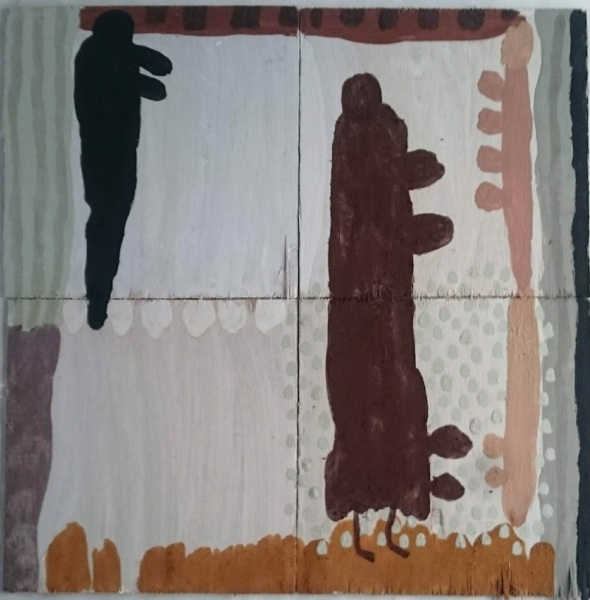 aspects of landscape and love – today it snowed (Cornish earth pigments on board; 51x51cm) © p ward 2019
aspects of landscape and love – today it snowed (Cornish earth pigments on board; 51x51cm) © p ward 2019
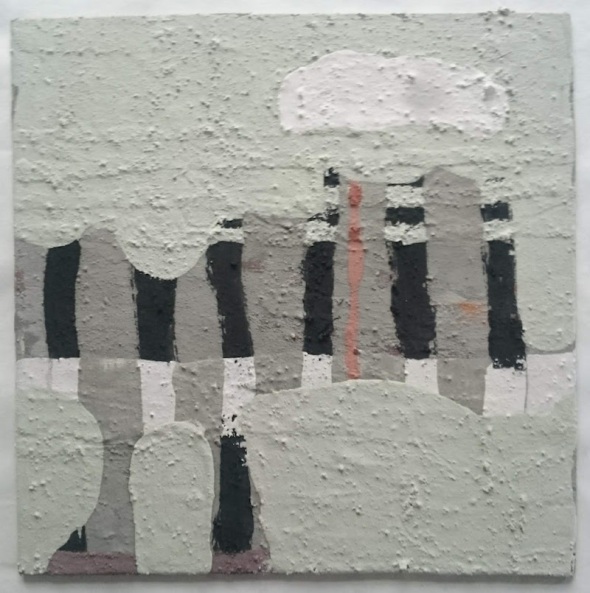 the beautiful things that people say when they are together (Cornish earth pigments on board; 25x25cm) © p ward 2019
the beautiful things that people say when they are together (Cornish earth pigments on board; 25x25cm) © p ward 2019
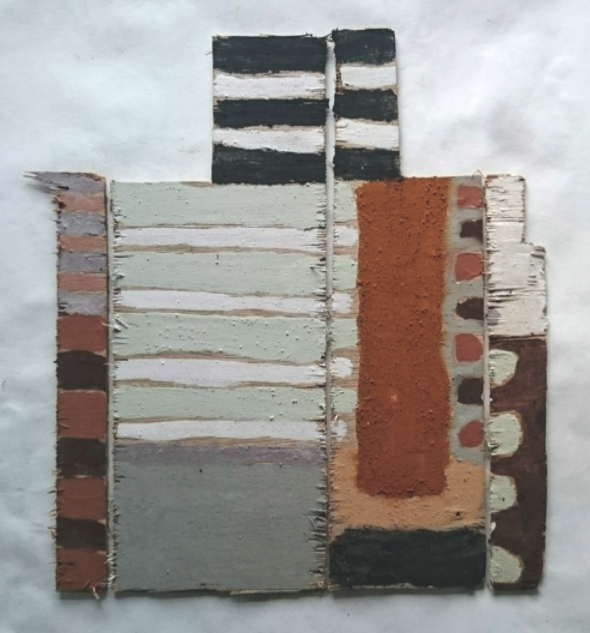 facing up to facing up to (Cornish earth pigments on board; 31x33cm) © p ward 2019
facing up to facing up to (Cornish earth pigments on board; 31x33cm) © p ward 2019
 rearranging the furniture (Cornish earth pigments on board; 35x35cm) © p ward 2019
rearranging the furniture (Cornish earth pigments on board; 35x35cm) © p ward 2019
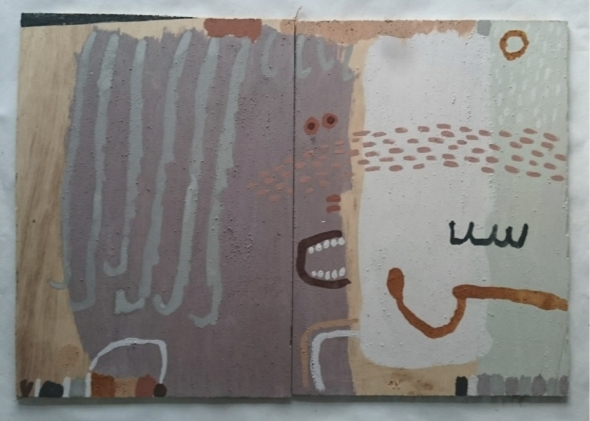 like chopping onions in a northwesterly gale (Cornish earth pigments on board; 56x38cm) © p ward 2019
like chopping onions in a northwesterly gale (Cornish earth pigments on board; 56x38cm) © p ward 2019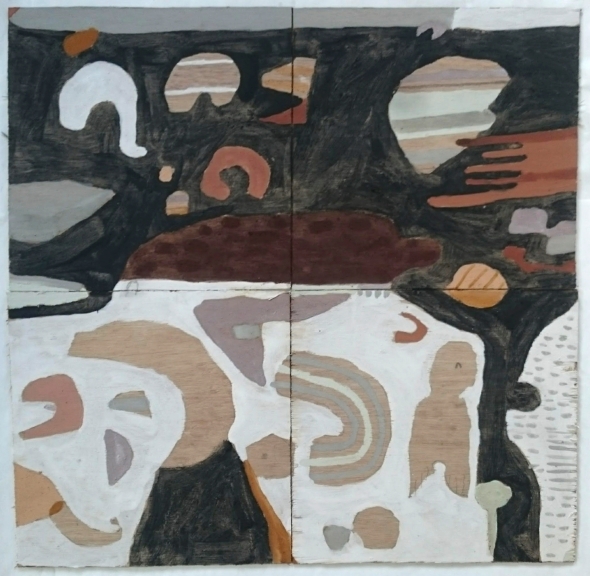 stones that stand in fields with swans and cows and geese: penwith (Cornish earth pigments on board; 70x68cm) © p ward 2019
stones that stand in fields with swans and cows and geese: penwith (Cornish earth pigments on board; 70x68cm) © p ward 2019
 simple communication here (Cornish earth pigments on card; 61x51cm) © p ward 2019
simple communication here (Cornish earth pigments on card; 61x51cm) © p ward 2019
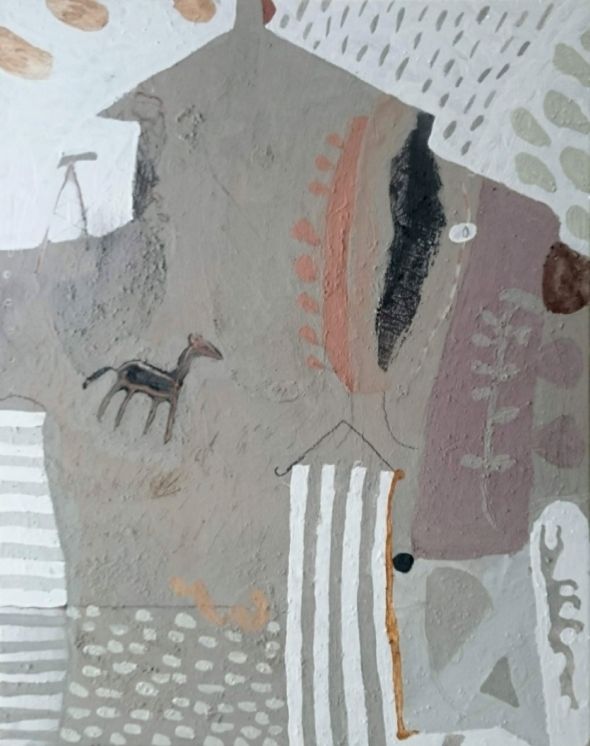 house of power (Cornish earth pigments on canvas; 40x50cm) © p ward 2019
house of power (Cornish earth pigments on canvas; 40x50cm) © p ward 2019
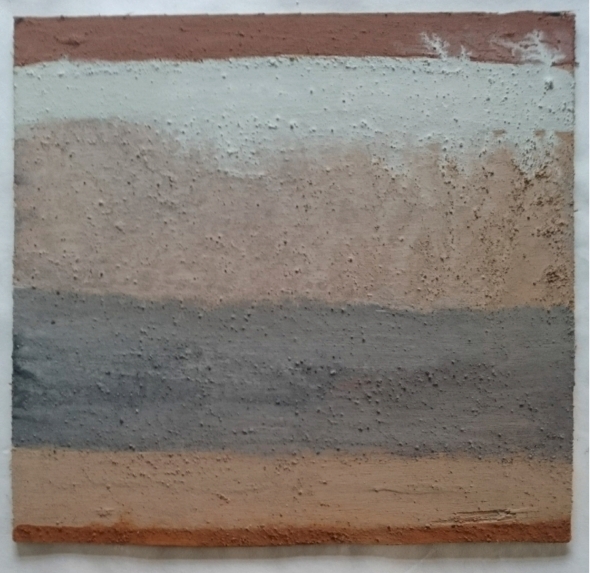 nondescript (Cornish earth pigments on board; 27x26cm) © p ward 2019
nondescript (Cornish earth pigments on board; 27x26cm) © p ward 2019
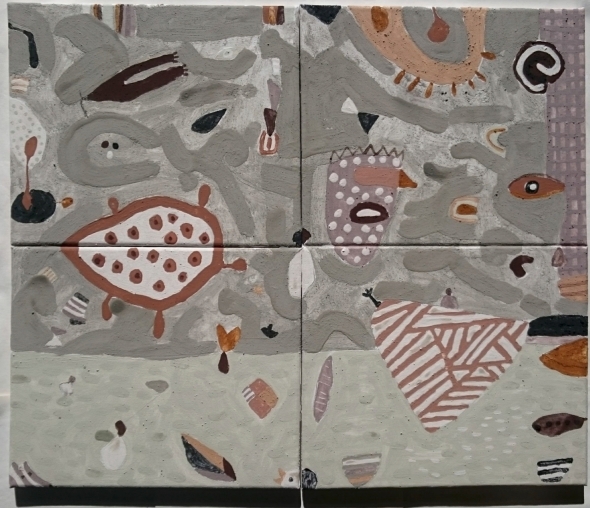 turning a new leaf with foxes on my mind (Cornish earth pigments on canvas; 61x51cm) © p ward 2019
turning a new leaf with foxes on my mind (Cornish earth pigments on canvas; 61x51cm) © p ward 2019
© P Ward 2019
painting within limits
Posted: January 26, 2019 Filed under: eARTh | Tags: Aesthetics, Arte Povera, Arts, arts research, Cornwall, Earth, earth pigments, eco art, ecopsychology, Environmental art, indigenous culture, painting, Pigment, Visual arts 1 Commentnew paintings from Cornwall – early 2019
For many years I have exclusively used colours from the earth in my paintings, gathering and processing all the pigments myself. Each location offers a unique palette and quality of colour to work with as well as a deeper understanding of that place.
To some it may seem as if creativity is being limited. “How can I paint the sky or the trees?” are frequent questions when running workshops. Working with earth pigments has changed the way I work and my understanding of painting in many ways. It has enriched my perception of colour and the ‘material’ of colour. Black is no longer “an absence of light”. For me it allows a specific expression of place orientated, of course, by my own relationship to being there.
The paintings here respond to the nature of earth colours and experiences in West Cornwall…
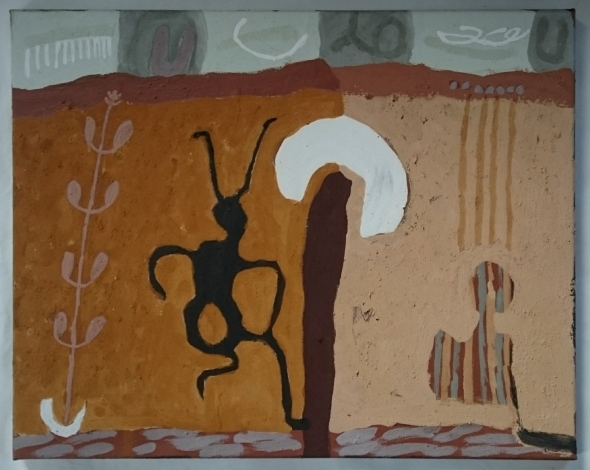 distance what we have become (Cornish earth pigments on canvas; 60x40cm) © p ward 2019
distance what we have become (Cornish earth pigments on canvas; 60x40cm) © p ward 2019
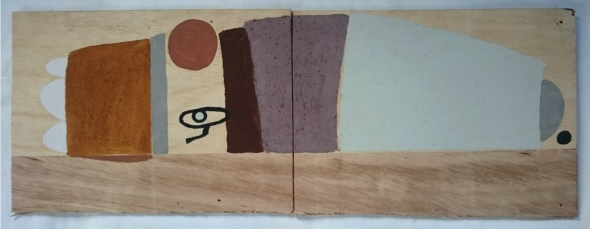 big red wolf moon that I did not see (Cornish earth pigments on board; 76x28cm) © p ward 2019
big red wolf moon that I did not see (Cornish earth pigments on board; 76x28cm) © p ward 2019
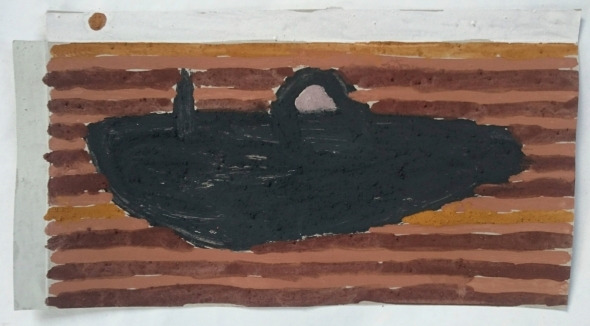 to run aground an island (Cornish earth pigments on card; 27x15cm) © p ward 2019
to run aground an island (Cornish earth pigments on card; 27x15cm) © p ward 2019
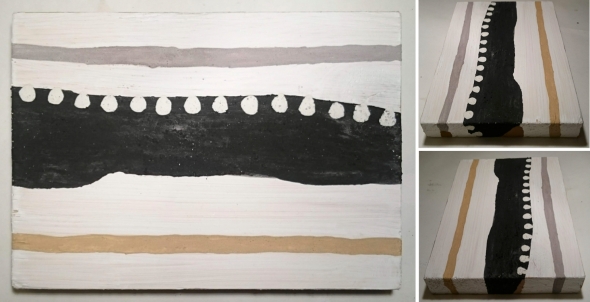 estuary (Cornish earth pigments on wood; 20×14.5x2cm) © p ward 2019
estuary (Cornish earth pigments on wood; 20×14.5x2cm) © p ward 2019
 untitled I, II, III (Cornish earth pigments on board; 25x26cm; 25x28cm; 25x26cm) © p ward 2019
untitled I, II, III (Cornish earth pigments on board; 25x26cm; 25x28cm; 25x26cm) © p ward 2019
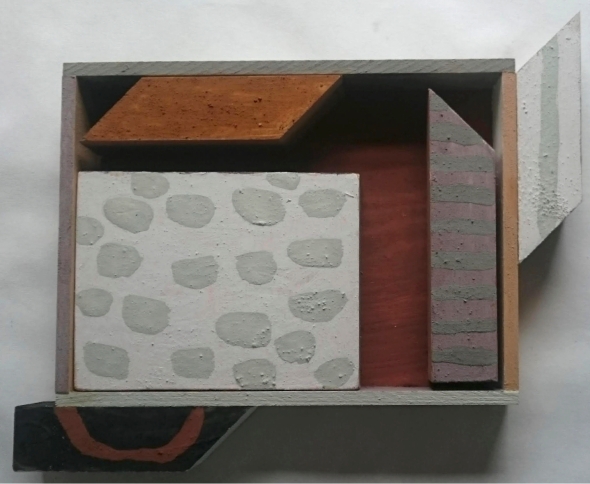 offcuts homestead (Cornish earth pigments on wood; 29x24x3cm) © p ward 2019
offcuts homestead (Cornish earth pigments on wood; 29x24x3cm) © p ward 2019
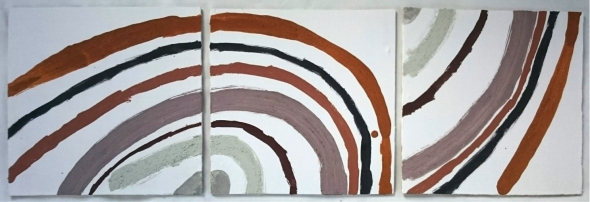 at fault (Cornish earth pigments on board; 80x26cm) © p ward 2019
at fault (Cornish earth pigments on board; 80x26cm) © p ward 2019
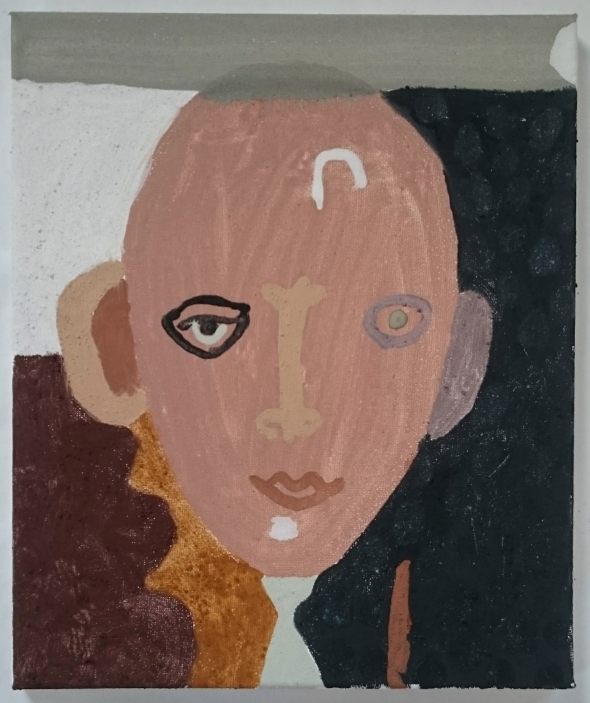 fairy queen (Cornish earth pigments on canvas; 25x30cm) © p ward 2019
fairy queen (Cornish earth pigments on canvas; 25x30cm) © p ward 2019
© P Ward 2019
Painting with Earth – Cornwall: new home, new works
Posted: November 30, 2018 Filed under: eARTh | Tags: Arte Povera, Arts, arts research, Cornwall, earth pigments, eco art, ecopsychology, Environmental art, Feeling, indigenous culture, painting, Pigment, poetry, Visual arts Leave a commentNovember 2018
despite the wind
despite the weather
despite the winter
despite the sense of vulnerability
this raw and new found exposure
despite the twisting and turmoil of our times
despite love
and loss
despite it all
this earth still shines
Before I embark on a new phase of experimentation, combining different binders with the Cornish pigments, I would like to share a few paintings that I have made in my new home – a caravan on a dairy farm in the coastal hills of west Penwith, Cornwall.
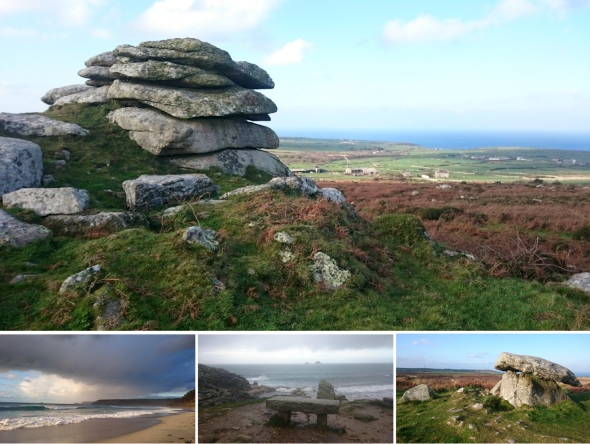 West Penwith, Cornwall – Morvah, Sennen Cove, Cot Valley and Chun Quoit © p ward 2018
West Penwith, Cornwall – Morvah, Sennen Cove, Cot Valley and Chun Quoit © p ward 2018
Here, I am surrounded by the historic land markings of the ancient peoples who populated this extremity of the British Isles. Stone walls, reportedly demarcating some of the oldest working field networks in the world, built 5000 years ago. Iron age hill forts, burial mounds, settlements and wells set in the denuded coastal wasteland of heath and moor. It is at times bleak. After the rain and wind that lashes fresh from the vast Atlantic ocean, the colours of autumn shine. The constantly changing hues of the blue and grey and turquoise sea. Rainbows sitting in our laps. The sky heavy and clear and dark and brooding. Salt water permeating. The animals are exposed by their hunt for food, by the lack of cover afforded by the stripped land. It is a place of spirit and history and life, right now.
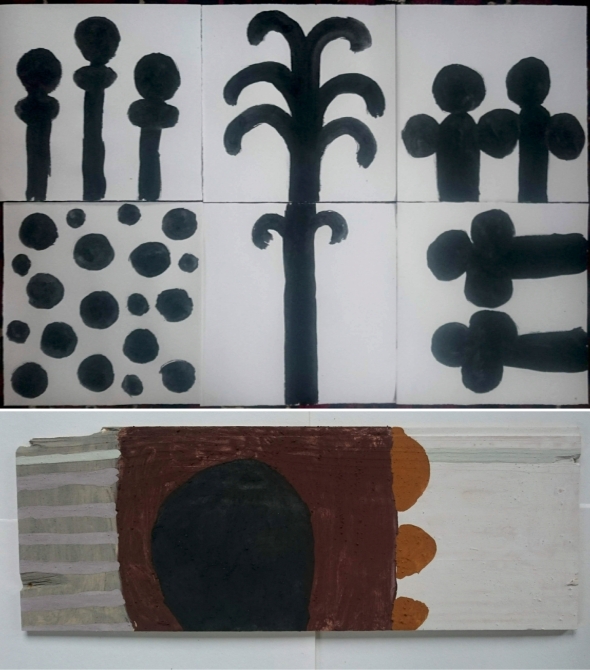 Penwith dream forms (Botallack black on paper); fogou (Cornish earth pigments on wood) © p ward 2018
Penwith dream forms (Botallack black on paper); fogou (Cornish earth pigments on wood) © p ward 2018
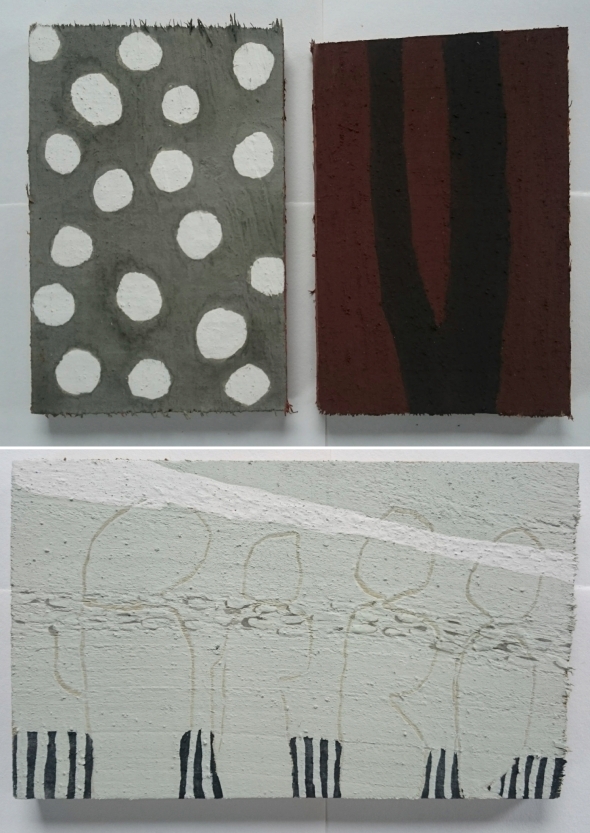 mineral, vegetable; mist (Cornish earth pigments on wood) © p ward 2018
mineral, vegetable; mist (Cornish earth pigments on wood) © p ward 2018
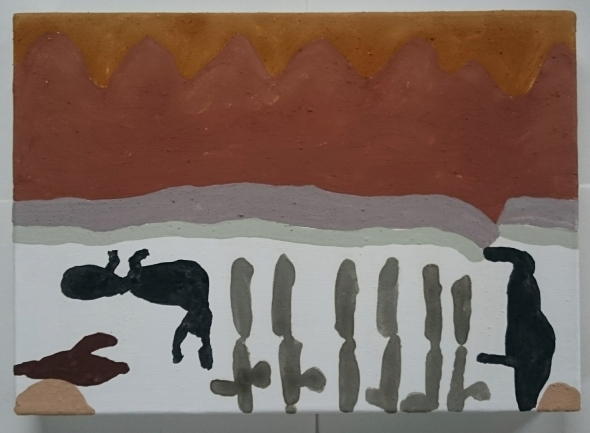 dance on the shore (Cornish earth pigments on canvas) © p ward 2018
dance on the shore (Cornish earth pigments on canvas) © p ward 2018
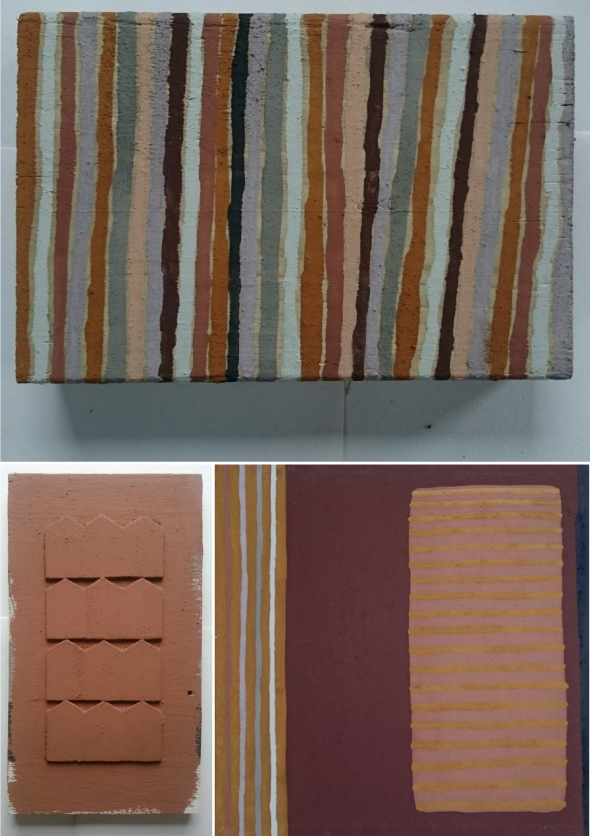 virtually vertical; community (Cornish earth pigments on wood); earth bound (Cornish earth pigments on canvas) © p ward 2018
virtually vertical; community (Cornish earth pigments on wood); earth bound (Cornish earth pigments on canvas) © p ward 2018
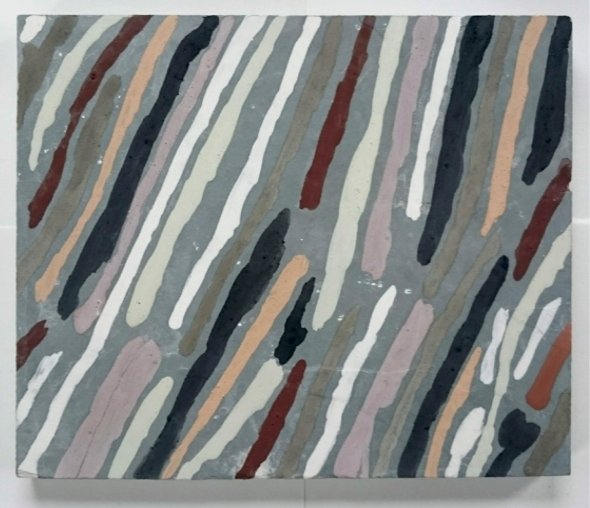 pigment drift (Cornish earth pigments on slate) © p ward 2018
pigment drift (Cornish earth pigments on slate) © p ward 2018
I am slowly learning to listen to the language of the colours here. The earth pigments, their qualities, their sources are unfamiliar. New to me. They are similar in colour to those of North Devon, that I have been using for a long time but very different in other ways. Their formation. Their nature. They have not been part of my own story, until now. The marks and stories they suggest are gradually revealing themselves. Their relationships unfolding. Their dynamic. And despite my attempts at integrity to their provenance and the spirit of this place in which I find myself, it is the freedom of my children’s paintings and drawings that are inspiring me…
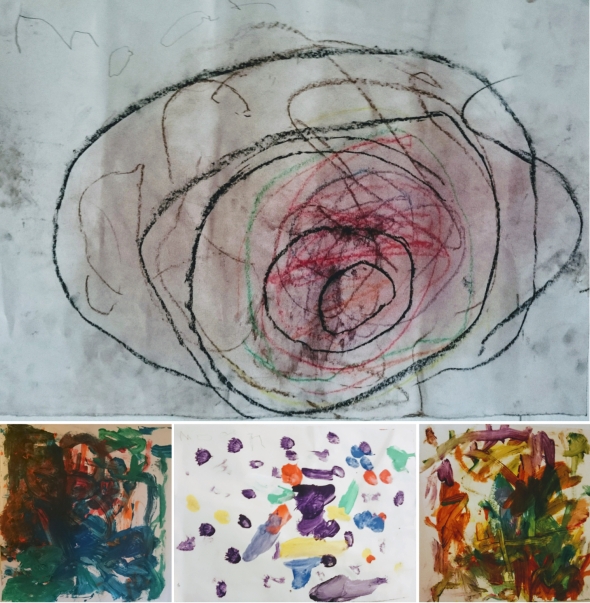 noah, agnes, noah, agnes (pastel and paint on paper) 2018
noah, agnes, noah, agnes (pastel and paint on paper) 2018
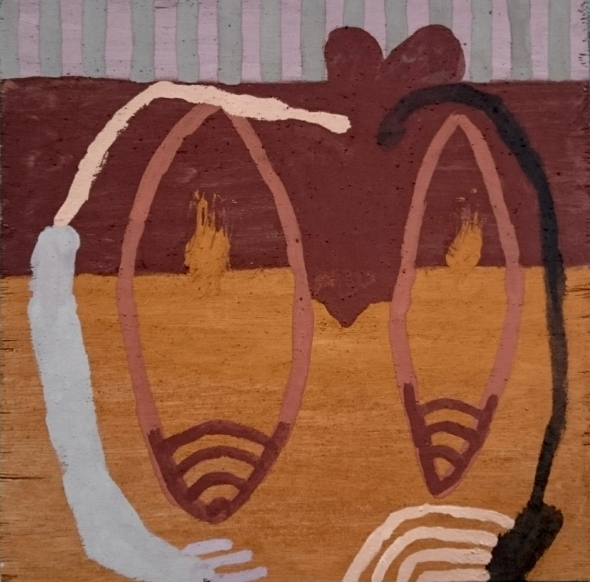 two heads (Cornish earth pigments on wood) © p ward 2018
two heads (Cornish earth pigments on wood) © p ward 2018
 eventual remediation (Cornish earth pigments on wood) © p ward 2018
eventual remediation (Cornish earth pigments on wood) © p ward 2018
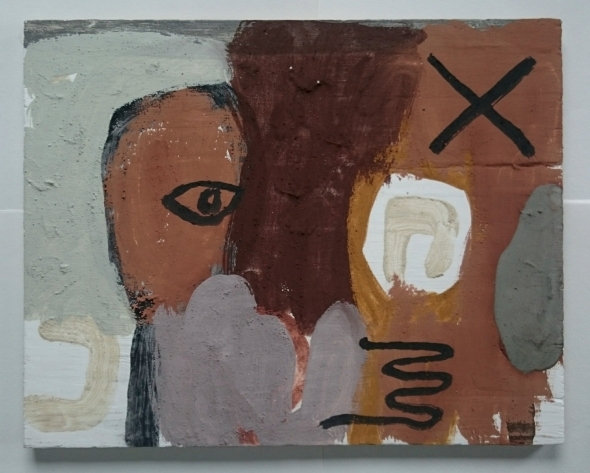 looking for love (Cornish earth pigments on wood) © p ward 2018
looking for love (Cornish earth pigments on wood) © p ward 2018
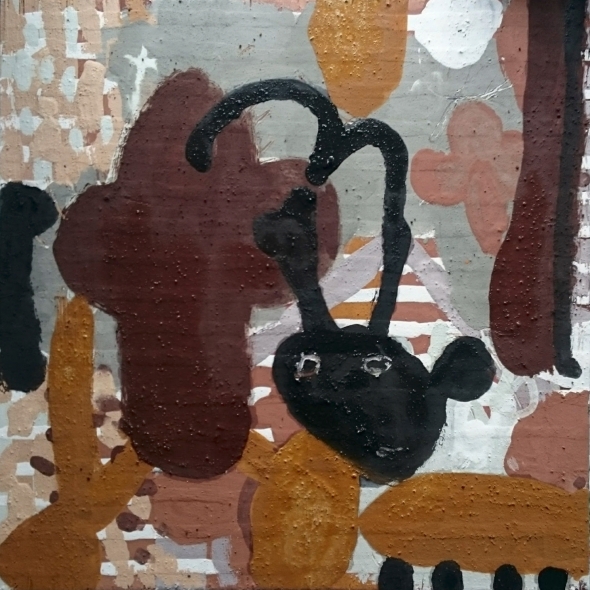 Cornish Folk Tale I (Cornish earth pigments on wood) © p ward 2018
Cornish Folk Tale I (Cornish earth pigments on wood) © p ward 2018
Professionally, I am working on an Arts Council National Lottery Project Fund proposal in association with Geevor Tin Mine to research the creative and educational potential of the pigments. Through recent projects and contact with the staff at the Mine I have started to appreciate and become really excited by the rich historical, geological, chemical and social provenance that the colours carry. After the far-reaching and ongoing success that Painting with Earth – North Devon has brought, let’s hope I will get some real financial support to enable the continuation of this rich seam of work ;-).
© P Ward 2018
new home new earth
Posted: February 5, 2018 Filed under: eARTh | Tags: Art, Arte Povera, Arts, arts research, Cornwall, Cornwall Area of Outstanding Beauty, earth pigments, eco art, Ecology, Environmental art, Geevor Mine, Levant Mine, Mining, Pigment, Visual arts, West Penwith 2 Commentsdiscovering colour in west cornwall
 Pendeen, Trewellard, Boscaswell and Geevor Mine, Cornwall © p ward 2018
Pendeen, Trewellard, Boscaswell and Geevor Mine, Cornwall © p ward 2018
moving home is always an exciting (if not somewhat stressful) time for discovery, for exploration, for new knowledge and for refreshment of life paths. I have recently moved with my family from North Devon to West Cornwall, as far south and west as one can go in the British Isles (apart from the Isles of Scilly, of course). The move was made to connect with the flourishing and historic arts scene in the area – Newlyn and St Ives on the Penwith peninsula being significant places in British art history over the last few centuries. The area is also remarkable for the globally significant tin and copper mining industries that flourished during the nineteenth century providing a wealth of metal ores and new technologies that contributed to mining knowledge around the world. The industry has now all but died out, due to cheaper sources elsewhere, but has left its mark ecologically and architecturally to this rugged, wet and windy section of Atlantic coast.
 Sennen Cove, Cornwall © p ward 2018
Sennen Cove, Cornwall © p ward 2018
 Rainbow over Geevor Mine, Cornwall © p ward 2018
Rainbow over Geevor Mine, Cornwall © p ward 2018
 Phone Box collection, Trewellard, Cornwall © p ward 2018
Phone Box collection, Trewellard, Cornwall © p ward 2018
 Lamppost, Pendeen, Cornwall © p ward 2018
Lamppost, Pendeen, Cornwall © p ward 2018
 Leswidden block works, St Just, Cornwall © p ward 2018
Leswidden block works, St Just, Cornwall © p ward 2018
 ‘Montol’ Midwinter celebrations, Penzance, Cornwall © p ward 2018
‘Montol’ Midwinter celebrations, Penzance, Cornwall © p ward 2018
 Turning on the Mousehole Lights, Cornwall © p ward 2018
Turning on the Mousehole Lights, Cornwall © p ward 2018
having spent the last ten years intensively researching the geology, history and uses of earth pigments found in North Devon, and establishing an international reputation through it, it is quite nerve wracking to up sticks and start again. Added to this sense of newness, is that of the unfamiliar. North Devon is my mother’s family home and a region I have known all my life. While the wild and austere beauty of West Penwith is visually and culturally inspiring it will be a while before I feel it as my home, despite feeling very comfortable here, nestled in a cosy old granite cottage close to the north coast. However, the process of taking root has begun and exploration to reveal the individual peculiarities of my new home, and especially those qualities that appeal to my own nature, have gripped my thoughts and actions.
 Lanyon’s Quoit, Penwith, Cornwall © p ward 2018
Lanyon’s Quoit, Penwith, Cornwall © p ward 2018
 Merry Maidens stone circle, Penwith, Cornwall © p ward 2018
Merry Maidens stone circle, Penwith, Cornwall © p ward 2018
 Lanyon’s Quoit in the mist, Penwith, Cornwall © p ward 2018
Lanyon’s Quoit in the mist, Penwith, Cornwall © p ward 2018
within six weeks we have found four excellent and bold earth colours locally, associated with historic mining activities. We have revealed a dolmen in our living room as well as starting to visit the plethora of ancient megalithic sites in the area. The sea, the mist, the rocks and wind are ever present on this extreme peninsula, the most exposed place I have ever lived. Having studied for my MA in Falmouth and consequently visited the county on numerous occasions, I am vaguely familiar with the area and some of the sites of interest, but was unaware of the incredible natural and cultural richness it provides. The county of Cornwall is one of the few Celtic strongholds on the British Isles, with its own language and a pride in its unique history, both ancient and modern. This is evident in so many ways – its folklore, place names, wildlife, art and its connection to the sea and land. I am very excited to see how this feeds my own creative output.
 Levant mine entrance, Cornwall © p ward 2018
Levant mine entrance, Cornwall © p ward 2018
 Red ‘clay’ at Geevor Tin Mine, Cornwall © p ward 2018
Red ‘clay’ at Geevor Tin Mine, Cornwall © p ward 2018
 Bottallack Mines, Cornwall © p ward 2018
Bottallack Mines, Cornwall © p ward 2018
 Purple and red ‘clays’ at Levant Mine, Cornwall © p ward 2018
Purple and red ‘clays’ at Levant Mine, Cornwall © p ward 2018
 Leswidden China Clay Pits, nr St Just, and Spoil heaps at Tywarnhayle Mine, Porthtowan, Cornwall © p ward 2018
Leswidden China Clay Pits, nr St Just, and Spoil heaps at Tywarnhayle Mine, Porthtowan, Cornwall © p ward 2018
the pigments we have gathered so far include red and purple ‘clays’, residues from the slag heaps at Levant Tin Mine, apparently deposited alongside, and hence coloured by oxides within, the seams of black tin (casserite) found in cracks in the 340 million year old granite mass that forms the majority of landmass here. The huge forces, pressures and temperatures experienced as the molten granite forced its way through weaknesses in the overlying Devonian sediment created a wealth of opportunities for metallic minerals ores to form alongside metamorphic rocks. According to one source the area has some of the most varied and mineral rich geologies in the world! We have collected a yellow ochre-like residue from mine waste heaps further northeast at Tywarnhayle Mine, Porthtowan. The yellow deposit also contains fragments of ‘green’ rock that will be interesting to separate and hopefully use. The oldest China Clay pits, formed in lakes as eroded granite deposits, can also be found near St Just in Penwith with a wealth of local history and national significance. We have been given access to this beautiful smooth white clay by the present landowner, whose father spent some time working in the drying kilns on site during his youth. We are experimenting with different approaches to processing the raw pigments, relying on water extraction, sieving and drying, similar to historic methods of extracting ore, rather than the more physical drying and grinding that we employed with the very different pigments in North Devon. This is partly due to the different nature of the raw pigments but also as a safeguard against inhaling potentially dangerous bi-products of the mining residues, such as arsenic! We are presently seeking geologists to aid in our research.
 shapes, marks, patterns and forms, Cornwall © p ward 2018
shapes, marks, patterns and forms, Cornwall © p ward 2018
 textures and marks, Penwith, Cornwall © p ward 2018
textures and marks, Penwith, Cornwall © p ward 2018
As you can see, it’s all really exciting stuff. However, as yet, we are still to find a suitable workspace, tubs of pigment being stored and worked on convenient window ledges and in the cramped garden shed. But time will work its magic and the right space will reveal itself. We have already been made aware of a possible arts space development in old buildings at the entrance to the mining museum at Geevor mine in our village, as well as studio spaces associated with the established art schools of St Ives and Newlyn. Work still continues elsewhere too with talks and workshops coming up in North Devon and further afield in East Sussex, so all is good with the world. And all this while juggling childcare priorities and other homemaking eventualities. So, thank you to family and friends for your support during our transition and also to the warm welcome and help we have received from the local community. I am certainly looking forward to seeing how everything unfolds…
 Geevor Tin Mine, Cornwall © p ward 2018
Geevor Tin Mine, Cornwall © p ward 2018
 Levant Mine, Cornwall © p ward 2018
Levant Mine, Cornwall © p ward 2018
 Geevor and Levant mines, Penwith Heritage Coast, Cornwall © p ward 2018
Geevor and Levant mines, Penwith Heritage Coast, Cornwall © p ward 2018
© P Ward 2018
in Transit…
Posted: November 5, 2017 Filed under: activ8, Uncategorized | Tags: Arte Povera, Arts, arts research, eco art, ecopsychology, Environmental art, graffiti, North Devon Coast, poetry Leave a commentnew works of a more temporary nature…
.
“Because things are the way they are, things will not stay the way they are.” Bertolt Brecht
.
what does one do when one is in transit, on the move, between stations, so to speak?
just how does one occupy oneself in a meaningful and creative manner when one’s foundations are all asunder, albeit temporarily?
it is a most unsettling situation indeed (quite literally), this moving about, this uprooting and replanting, this altering of, well, almost everything…
.
perceptions
perspectives
.
I am making ready for change
but unwilling to predict or control just how such changes may manifest.
they will more than likely simply emerge quite naturally,
not without a struggle perhaps,
but in an organic way.
.
in the meantime
there is the matter of packing away stuff,
clearing space for the new
both physically and emotionally,
and simply getting rid of that which no longer serves a purpose.
then there is of course the more mundane,
taking advantage of a lull or space to administer and catch up with paperwork and websites etc
and, of course, the constant reflection upon where one has been, where one is now and where one might like to go…
.
the studio, my place of creative refuge for two years is already dismantled
neatly stowed in a safe space, a strange sensation, a sense of detachment from my life vocation.
and yet all this has been done before.
and we adapt,
we make the most of what we have,
we continue to create, to cast our influence in the world
and the new situation inspires newness in all
.
it is rather exciting
this nomadic nuance
.
so here’s to new life
to new possibilities
to uncertain futures
.
isn’t it always this way after all…
.
 walking up Holdstone Down, Exmoor, North Devon © f owen 2017
walking up Holdstone Down, Exmoor, North Devon © f owen 2017
 après les Perrières (boots, sheep dung necklace, ibis feathers, clay model (courtesy Majid Ziaee*), tickets, red valerian sprig, stick and string) © p ward 2017
après les Perrières (boots, sheep dung necklace, ibis feathers, clay model (courtesy Majid Ziaee*), tickets, red valerian sprig, stick and string) © p ward 2017
 flowers and earth, red valerian posy, earth pigments, pestle and mortar © p ward 2017
flowers and earth, red valerian posy, earth pigments, pestle and mortar © p ward 2017
 XO, boots with ball clay and cordyline parcels © p ward 2017
XO, boots with ball clay and cordyline parcels © p ward 2017
 red valerian posy © p ward 2017
red valerian posy © p ward 2017
 walk in Brownsham Woods, Hartland, Devon © p ward 2017
walk in Brownsham Woods, Hartland, Devon © p ward 2017
 tides, offcuts on canvas; we are a break in the waves (my beach) © p ward 2017
tides, offcuts on canvas; we are a break in the waves (my beach) © p ward 2017
 walk at Shirley Heights, London © p ward 2017
walk at Shirley Heights, London © p ward 2017
 woodland graffiti, Shirley Heights, London © p ward 2017
woodland graffiti, Shirley Heights, London © p ward 2017
 les trois galets de Marc Averly; Prince Albert Bridge, River Thames, from Battersea Park, London** © p ward 2017
les trois galets de Marc Averly; Prince Albert Bridge, River Thames, from Battersea Park, London** © p ward 2017
 les trois galets de Marc Averly; Peace Pagoda, Battersea Park, London** © p ward 2017
les trois galets de Marc Averly; Peace Pagoda, Battersea Park, London** © p ward 2017
 les trois galets de Marc Averly; Turbine Hall, Tate Modern, Southbank, London** © p ward 2017
les trois galets de Marc Averly; Turbine Hall, Tate Modern, Southbank, London** © p ward 2017
 OXO – the City from the Southbank, London © p ward 2017
OXO – the City from the Southbank, London © p ward 2017
 pavement arrangement, Shirley, London © p ward 2017
pavement arrangement, Shirley, London © p ward 2017
 les trois galets de Marc Averly; Stonehenge, Salisbury Plain, Wiltshire** © p ward 2017
les trois galets de Marc Averly; Stonehenge, Salisbury Plain, Wiltshire** © p ward 2017
 daisy earth ball; procession; Stonehenge, Wiltshire © p ward 2017
daisy earth ball; procession; Stonehenge, Wiltshire © p ward 2017
 new year sunrise, Hele, North Devon © p ward 2017
new year sunrise, Hele, North Devon © p ward 2017
 no Wales today, from Hillsborough, North Devon © p ward 2017
no Wales today, from Hillsborough, North Devon © p ward 2017
 samhain, Hele (heal), North Devon © p ward 2017
samhain, Hele (heal), North Devon © p ward 2017
 offcut composition, wood © p ward 2017
offcut composition, wood © p ward 2017
 3 is better than 2 (apparently), Lynmouth, North Devon © p ward 2017
3 is better than 2 (apparently), Lynmouth, North Devon © p ward 2017
 brick, Lynmouth North Devon © p ward 2017
brick, Lynmouth North Devon © p ward 2017
 Contisbury Head, from Lynmouth © p ward 2017
Contisbury Head, from Lynmouth © p ward 2017
 driftwood arrangement, Lynmouth, North Devon © p ward 2017
driftwood arrangement, Lynmouth, North Devon © p ward 2017
 finding a temporary equilibrium, Lynmouth, North Devon © p ward 2017
finding a temporary equilibrium, Lynmouth, North Devon © p ward 2017
with many thanks to family and friends, new and old…
© P Ward 2017
* http://www.majidziaee.com/index.php/en/
** Les Trois Galets de Marc Averly is a project by French artist Marc Averly (https://www.facebook.com/marc.averly) . He asks friends to photograph his hand formed wooden ‘galets’ in different places around the world and is compiling a fascinating and entertaining compendium of the images. Much of Marc’s work focuses on wood and trees, and he has a massive knowledge around the subject that he shares at interdisciplinary symposiums and workshops.
Global Nomadic Art Project France 2017
Posted: September 27, 2017 Filed under: A BUNDLE OF STICKS, activ8, eARTh, the ash tree, Uncategorized | Tags: #GNAP France 2017, Arte Povera, Arts, arts research, collaboration, earth pigments, eco art, Ecology, Environmental art, Land Art, painting, Pigment, Visual arts 1 CommentArt Underground
 Residency group photo © GNAP France 2017
Residency group photo © GNAP France 2017
In early September I was fortunate to be among 22 international artists (from as far afield as South Korea, USA, India, New Zealand, Iran, Australia, Germany, Italy and France) warmly invited to Doué en Anjou in the Saumur Region of the Loire, France, to live and work amongst the plethora of caves that sit just beneath the surface. During the 10 day residency we were taken to troglodyte habitations, sarcophagus workshops, a zoo, a farm, a quarry, a woodland lake, art galleries, champagne cellars, vineyards and restaurants as well as sites along the Loire to create site-specific nature-based works. Final installations and video works were presented to an audience of 900 sponsors, local school children, press, dignitaries and the general public at Les Perrieres cave centre as part of the national Heritage celebrations. The residency, part of a series throughout Europe organized by YATOOi during 2017, was a wonderfully rich and playful cultural exchange supported by local generosity and inspiring an outstanding depth and variety of work reflecting the diverse backgrounds and environments shared.
 residency visits and hospitality © GNAP France 2017
residency visits and hospitality © GNAP France 2017
 residency site visits © p ward/GNAP France 2017
residency site visits © p ward/GNAP France 2017
 Magdelene Dolmen, GNAP France © p ward 2017
Magdelene Dolmen, GNAP France © p ward 2017
Despite the difficulties of language good friendships were established through common acts of work and play, through the joyful sharing of cultural peculiarities and through shared experience, all helped by a plentiful supply of local wine and champagne – we were in France after all! The generosity and openness of the local people, businesses and sponsors to a group of unknown artists descending into the area was quite remarkable. All events within the residency – openings, introductions, public presentations and the final exhibition – were all well and enthusiastically attended. Much credit should of course be given to the residency organizers (Olivier Huet and Magrit) who brought such bounty to the group and facilitated the residency in a wonderfully warm, relaxed and friendly manner. As you can see from the program we were kept very busy during the residency adding an enjoyable intensity to proceedings.
 residency program © GNAP France 2017
residency program © GNAP France 2017
 Les Perrieres, cave visitor centre © Sally Kidall 2017
Les Perrieres, cave visitor centre © Sally Kidall 2017
The work, framed within the residency as ‘Nature’ or ‘Land’ Art, was created during short ’workshops’ (visits) to places of interest or relevance to the theme of ‘Art Underground’. It was hoped that through simple introductions to the history, ecology and geology of the places we would build up a sense of the extraordinary dual (underground/surface) character of the region. Throughout the first week we all developed a better relationship to and sense of the materials prevalent and formative to the area. This knowledge allowed us to slowly form ideas for a final piece to be installed or shown within or near the cave complex at Les Perrieres where we were so comfortably accommodated. The cave complex is a fantastic attraction in itself, catering for public and school groups, having employed artists to interpret and enrich the network of caves carved from the earth for building materials over the last 500 years. The experience of spending such a lot of time underground, to emerge intermittently into the ‘light’, was at once quite disorientating and somehow reassuring, and also hard to describe. (Returning home to a small house in the English countryside, with windows overlooking a valley, certainly felt very strange.)
 Seven Bodies, GNAP France © Atefah Khas 2017
Seven Bodies, GNAP France © Atefah Khas 2017
 peter ward, GNAP France workshop installations © p ward 2017
peter ward, GNAP France workshop installations © p ward 2017
As an artist (maybe overly) academically acquainted with the various forms and history of environmental art it was fantastically refreshing to simply make – to spend time with others in an environment, to explore new and familiar materials in a different context and to enjoy the varied processes employed by the other artists. The care and attention both in making, recording and documenting that was adopted by many was an inspiration. An amazing skill for choosing sites for installations where they may be viewed and documented best was also apparent, as was an enviable dexterity with digital editing and animation among the group.
 ombre, GNAP France © Valeria Codara 2017
ombre, GNAP France © Valeria Codara 2017
 Marc Avery, Majid Ziaee, Donald Buglass, Valeria Codara, Joël Thépault © GNAP France/Joël Thépault 2017
Marc Avery, Majid Ziaee, Donald Buglass, Valeria Codara, Joël Thépault © GNAP France/Joël Thépault 2017
 Pierre Guilloteau, Joël Thépault, Isabelle Aubry, Roger Rigorth © GNAP France 2017
Pierre Guilloteau, Joël Thépault, Isabelle Aubry, Roger Rigorth © GNAP France 2017
 Essentials Atefeh Khas/Roger Rigorth, Joël Thépault © Atefeh Khas/Roger Rigorth/Joël Thépault/GNAP France 2017
Essentials Atefeh Khas/Roger Rigorth, Joël Thépault © Atefeh Khas/Roger Rigorth/Joël Thépault/GNAP France 2017
 Gunjan Tyagi (and friends) © GNAP France 2017
Gunjan Tyagi (and friends) © GNAP France 2017
 Sally Kidall/Cherie Sampson, Pascale Planche, Soon-im Kim, Lee Sun-ju, Aarti Zaveri © GNAP France 2017
Sally Kidall/Cherie Sampson, Pascale Planche, Soon-im Kim, Lee Sun-ju, Aarti Zaveri © GNAP France 2017
 Ahmad Nadalian, Roger Rigorth, Pascale Planche, Patrick Tagoe-Turkson, Gunjan Tyagi, Ute Ritschel © GNAP France 2017
Ahmad Nadalian, Roger Rigorth, Pascale Planche, Patrick Tagoe-Turkson, Gunjan Tyagi, Ute Ritschel © GNAP France 2017
 Public Presentations, Philippe Noiret Theater of Doué-en-Anjou © GNAP France 2017
Public Presentations, Philippe Noiret Theater of Doué-en-Anjou © GNAP France 2017
 martyr, objets trouvé, © p ward 2017
martyr, objets trouvé, © p ward 2017
The lack of academic analysis and critique, whether by design or through language difficulties, was simply refreshing. While Land Art or Nature Art may be acknowledged within an art historical context it is often totally dismissed (for which I have been guilty) as a relevant form or practice by more ecologically/socially engaged contemporary artists. For example, Richard Long is often criticized for simply taking formal and conceptual ideas out of the gallery or bringing ‘natural’ materials back in, while Andy Goldsworthy overly-aestheticizing Nature, without acknowledgement of any political issues relevant to subject, material or space, and Robert Smithson for the use of massively macho machinery to make vast changes to a landscape without consideration for ecological consequences. I now personally appreciate all as parallel and historical aspects to all work of and about the environment – Art does not always have to be so overtly political after all, working intrinsically and subliminally within culture as a whole.
 oP77, earth pigments, GNAP France © p ward 2017
oP77, earth pigments, GNAP France © p ward 2017
The experience of GNAP France has given me a fresh perspective on my own prejudices, reiterating the value of personal tactile experience and expression within an environment, offering the opportunity to celebrate and share aspects of nature that may often go unobserved on both a minute and architectural scale, as well as space to develop a deeper sense of oneself within Nature. It is all a learning process. The residency offered such a space to the artists with little pressure to produce but simply to participate – to make contacts, to observe and to share within an international setting: something many of us seldom have the chance to enjoy. In the words of Italian artist, Valeria Codara, “It is only when we open ourselves to others that new ideas can emerge” (one of the few political sentiments expressed towards any of the work during the residency). Whether the individual works had ‘value’ in a social or ecological sense beyond the artists’ experience is always debatable, but it cannot be denied that the creation and participation in the whole experience was a rich and deeply transformative process.
 portant un paquet de bâtons sur les bords de la Loire, GNAP France © peter ward 2017
portant un paquet de bâtons sur les bords de la Loire, GNAP France © peter ward 2017
 peinture d’arbres, GNAP France © peter ward 2017
peinture d’arbres, GNAP France © peter ward 2017
The group of artists came from quite different creative backgrounds, culturally and professionally. We were also at various stages in our careers, the GNAP France residency offering differing possibilities for each of us. International networking, including the chance to really meet people we were otherwise only aware of online, was a key element as well as an international flavour to add to our profiles. Work-wise, while many of us approached each site afresh, many brought signature themes and forms to their responses. French artist Pierre Guilloteau brought along his deconstructed ‘wooden ball’ to reconstruct at various sites to great affect as part of his ongoing Longitude 0° project. Others created simple animations or filmed and produced performance pieces – quite a feat in such short periods of time. Some work was monumental in scale some definitely quite ethereal. Some worked with others, some alone. Thankfully there was a fair share of humour too.
 presse à la terre; bétail grotte, GNAP France © peter ward 2017
presse à la terre; bétail grotte, GNAP France © peter ward 2017
Despite a renewed appreciation of the craft, delicacy and aesthetic appeal of some of the more ethereal sculptural pieces my own work remained closely linked to a sense of our contemporary global situation. I certainly played within the aesthetics of unfamiliar materials but feel my stronger works expressed Nature not as a pristine, balanced, elemental world but as a turbulent shifting ecology within which humankind plays an often provocative and sometimes frivolous role (if we are willing to get the joke!?). During the week I began to recognize patterns emerging in my practice. Ways in which I become attuned to a landscape, such as gathering sticks or forming balls from soil, from which the work would develop. There was often a sense of ritual to my process, acknowledging elemental forces within each installation. There was a sense of passing to the final pieces, suggestions of something that had happened to which others were witness, often tinged with sadness and destitution, sometimes with joy. I started to understand the importance of narrative within my work (thank you Sally).
 perdant un jeu, objets trouvé, GNAP France © peter ward 2017
perdant un jeu, objets trouvé, GNAP France © peter ward 2017
For my own final piece, en passant par (passing through), I secured a large cave between two quarries. I was personally drawn to the combination of contemporary objects, surfaces and detritus as well as an abundance of usable natural materials in the space. My intention was to create an immersive experience using pigments, objects, imagery and ideas I had gathered throughout the residency. As an artist working with natural materials and pigments I am often forced to question or recognize the connection between cave art and graffiti. The space and residency offered an excellent opportunity to explore this more fully. I hoped to create a sense of the ‘artist’ passing through, a ‘nomad’, using the cave as a temporary habitation and workspace. Also to highlight the imaginative possibilities of the shapes, textures and structures already evident in the space through a minimal intervention of mark-making and objects. For me it was the largest and most ambitious project I have attempted to date. Thankfully it was well received by fellow artists and the public.
 en passant par, cave installation (detail), objets trouvé and earth pigments, GNAP France © peter ward 2017
en passant par, cave installation (detail), objets trouvé and earth pigments, GNAP France © peter ward 2017
 en passant par, cave installation (detail), objets trouvé and earth pigments, GNAP France © peter ward 2017
en passant par, cave installation (detail), objets trouvé and earth pigments, GNAP France © peter ward 2017 en passant par, cave installation (detail), objets trouvé and earth pigments, GNAP France © peter ward 2017
en passant par, cave installation (detail), objets trouvé and earth pigments, GNAP France © peter ward 2017
GNAP France is certainly an event I will never forget: as a time of learning, living and working on many new levels and having loads of fun with some beautiful new friends, rejuvenating my confidence, ambition and motivation as an artist. I can only thank all those involved – artists, organizers and sponsors – for their generosity in creating such an incredible encounter.
Thank you all for welcoming me so wholeheartedly to the GNAP family.
© P Ward 2017
__________________________________________________________________
GNAP France 2017 was curated by Olivier Huet (association Cranberry) www.gnap-france.fr
List of artists: Isabelle Aubry (France), Marc Averly (France), Claudette Besnard (France), Donald Buglass (New Zealand), Karin Chopin (France), Valeria Codara (Italy), Pierre Guilloteau (France), Atefeh Khas (Iran), Sally Kidall (Australia), Kim Soon-im (South Korea), Lee Sun-ju (South Korea), Ahmad Nadalian (Iran), Pascale Planche (France), Joël Thépault (France), Roger Rigorth (Germany), Ute Ritschel (Germany), Cherie Sampson (USA), Patrick Tagoe-Turkson (Ghana), Gunjan Tyagi (India), Peter Ward (UK), Aarti Zaveri (India), Majid Ziaee (Iran).
sponsors, GNAP France 2017
(Images are from my own collection or made available to me by request or through Yatoo Gnab Facebook pages. All images and works retain copyright to the artist and Yatoo GNAP. I hope I have mentioned everybody? Apologies for so many pictures of my work but hey!…:-))
painting in croatia, june 2017
Posted: August 2, 2017 Filed under: A BUNDLE OF STICKS, activ8, eARTh, the ash tree, Uncategorized | Tags: Arte Povera, Arts, arts research, Croatia, Dugi Otok, earth pigments, ecopsychology, Environmental art, indigenous culture, painting, Pigment, Visual arts 1 CommentOn a recent visit to the ‘long island’ of Dugi Otok on the Adriatic coast of Croatia I was taken by the unfamiliar marks of paint daubed on walls and buildings. Not graffiti as such or even nonsensical paintbrush cleansing ablutions but intentional spots and splashes of household paint. We thought they were maybe way markers or boundary signs. Whatever their purpose I enjoyed how they honed my vision both to the unfamiliar in such a rich but alien culture and also to another sense of painting in and of the environment. rocks and soil I + II, framed; dugi otok, croatia © p ward 2017
rocks and soil I + II, framed; dugi otok, croatia © p ward 2017
 dockside paintings; sali, croatia © p ward 2017
dockside paintings; sali, croatia © p ward 2017
Wherever we travel it is the unfamiliar colours, patterns, shapes, sounds, smells, tastes and materials that inspire and refresh our imaginations and remind us of the richness, diversity and potential of this planet that we share while also refreshing the ‘familiar’ in our own backyards. It only leaves us, as creative people, to show our gratuitude through sharing our vision and inspiration with others, hopefully continuing the cycle.
 paint daubs; sali, croatia © p ward 2017
paint daubs; sali, croatia © p ward 2017
 le citron de provence (Gonepteryx cleopatra) butterfly wings; dugi otok, croatia © p ward 2017
le citron de provence (Gonepteryx cleopatra) butterfly wings; dugi otok, croatia © p ward 2017
 ant highway, roadkill toad, pink flowers, white admiral; sali, dugi otok, croatia © p ward 2017
ant highway, roadkill toad, pink flowers, white admiral; sali, dugi otok, croatia © p ward 2017
 festival procession flowers; sali, croatia © p ward 2017
festival procession flowers; sali, croatia © p ward 2017
 a boat and three doorways; sali, dugi otok, croatia @ p ward 2017
a boat and three doorways; sali, dugi otok, croatia @ p ward 2017
 confectionery constellation, casual installation, pink house; sali, croatia © p ward 2017
confectionery constellation, casual installation, pink house; sali, croatia © p ward 2017
 handprints and paint; sali, croatia © p ward 2017
handprints and paint; sali, croatia © p ward 2017
 urban sights I, II + III; sali, croatia © p ward 2017
urban sights I, II + III; sali, croatia © p ward 2017
 pigment and paint I + II; sali, croatia © p ward 2017
pigment and paint I + II; sali, croatia © p ward 2017
 playground moths; sali, croatia © p ward 2017
playground moths; sali, croatia © p ward 2017
 four colours; dugi otok, croatia © p ward 2017
four colours; dugi otok, croatia © p ward 2017
 sticks and stones; dugi otok, croatia © p ward 2017
sticks and stones; dugi otok, croatia © p ward 2017
 unfamiliar shrub; sali, croatia © p ward 2017
unfamiliar shrub; sali, croatia © p ward 2017
 red and yellow makes orange, walls; sali, croatia © p ward 2017
red and yellow makes orange, walls; sali, croatia © p ward 2017
 nature park telašćica, dugi otok, croatia © p ward 2017
nature park telašćica, dugi otok, croatia © p ward 2017
 flying; dugi otok, croatia © p ward 2017
flying; dugi otok, croatia © p ward 2017
With thanks to the people, animals, plants and places of Croatia for a most inspiring experience and to Francesca, Noah and Agnes for sharing it with me.
© P Ward 2017
back to basics
Posted: January 14, 2016 Filed under: eARTh | Tags: Arts, arts research, Bideford Black, Devon, Earth, earth pigments, eco art, Environmental art, North Devon, Pigment, Visual arts 1 Comment5 small earth paintings
Beaten by both the need for storage space for my work and, hopefully, a more commercially viable product I have resorted, and returned, to making a number of small earth pigment paintings on paper.
Originally I wanted to explore the layering and removal of water-based paint, similar to my past use of watercolour, using earth pigments. This worked well for one piece but I soon strayed back to the more recent pattern approach that working with earth pigments has inspired.
My method, as in the past, allows the pigments, the colours, textures and forms, to suggest and reveal the form of the finished piece. It can often take a while for the painting to evolve, employing a variety of accumulated intuitive, mark making and aesthetic decisions and skills to move forward. Working in this way is always fascinating, offering outcomes beyond my present understandings.
 back to basics 1 – earth pigment dreaming (earth pigments on watercolour paper) © p ward 2015
back to basics 1 – earth pigment dreaming (earth pigments on watercolour paper) © p ward 2015
 back to basics 2 – black form dreaming (earth pigments on watercolour paper) © p ward 2015
back to basics 2 – black form dreaming (earth pigments on watercolour paper) © p ward 2015
 back to basics 3 – joyful exchanges (earth pigments on watercolour paper) © p ward 2015
back to basics 3 – joyful exchanges (earth pigments on watercolour paper) © p ward 2015
 back to basics 4 – unctuous burnt umber (earth pigments on watercolour paper) © p ward 2015
back to basics 4 – unctuous burnt umber (earth pigments on watercolour paper) © p ward 2015
 back to basics 5 – grey and cream earth (earth pigments on watercolour paper) © p ward 2015
back to basics 5 – grey and cream earth (earth pigments on watercolour paper) © p ward 2015
Each painting measures 21x21cm and is on 300gsm watercolour paper. The pigments, a selection of six hand ground, locally gathered colours from North Devon, have been simply mixed with water and then fixed with pastel fixative. I am now looking forward to making more simple paintings on paper of different sizes to develop this approach.
The original paintings are available for sale online or later in the year at our new studio space at Hele Corn Mill, near Ilfracombe in North Devon.
For more information please contact me at earth.northdevon@gmail.com
© P Ward 2016
500 children!!
Posted: January 26, 2015 Filed under: A BUNDLE OF STICKS, activ8, BIOSPHERic, eARTh, educ8 | Tags: art and science, Arte Povera, Arts, arts research, Bideford Black, Devon, Earth, earth pigments, eco art, Ecology, ecopsychology, Environmental art, indigenous culture, Interdisciplinarity, North Devon, Pigment, Soil, Soil Culture, Visual arts, workshop 2 CommentsNEWPORT COMMUNITY INFANT ACADEMY ARTSWEEK 2015 – Soil Culture*
 500 children, communal painting, earth pigments on canvas © p ward 2015
500 children, communal painting, earth pigments on canvas © p ward 2015
I was recently invited to develop and lead environmental art activities for Newport Community School in Barnstaple, North Devon. The activities offered opportunities for staff and pupils to explore and celebrate our relationships with Nature, in particular soil and local earth pigments. The school has 500 pupils between 3 and 12 years old. A range of activities, including mud painting, making soil balls, bundles of sticks and leaf sorting, were presented to the teaching staff and then left for them to interpret. The communal artworks created were included in an exhibition for children and parents at the end of the week and a 6x1m earth pigment painting made by the whole school was left as legacy of the week’s hard work.
For me to develop such a large-scale event for so many was extremely daunting – how teachers do it day-in-day-out is amazing! It was incredible to see a painting evolve at the hands of 500 children, with only the most arbitrary guidelines, to become a vibrant expression of their experience and of North Devon itself. All participatory group paintings I have facilitated have somehow turned out well, but I have never tried it with 500 children before, and it is certainly a way of working I hope to pursue further in the future. The other simple activities, and reflection upon them, seemed to give children and staff space to try something new and also a space to learn through a different, more hands-on approach. The whole event has given me a great deal of satisfaction and confidence to tackle such events again in the future.
The exhibition was well attended by some most bemused but interested parents looking for their individual child’s work only to find it absorbed into the totality. The school, to their credit, thoroughly got behind both the educational and experiential value of art activities and also the contemporary conceptual nature of the final exhibition. Many thanks to Georgie Treanor for helping organize ARTSWEEK and to the children, teachers and staff for their patient and enthusiastic participation, and to Francesca for her support and help preparing the canvas.
 francesca hemming the canvas © p ward 2015
francesca hemming the canvas © p ward 2015
soil . making paint . local history . geology . local resources . environment . culture
INTRODUCTION to TEACHERS PACK
“Art does not reproduce the visible, but makes visible” Paul Klee
Art is one way we learn about the world. The learning and creative processes are based on both sensory experience and reflection. The process and expression of such experience is what we know as Art. From the beginning of human history we have learnt about the world through experience of the materials that are available in our immediate surroundings. From this experience, and through trial and error, we have developed the technologies to enable us to survive. As communications and transport have become more versatile and far reaching we have often lost our knowledge and understanding of the local environment and the materials it provides.
In North Devon, as elsewhere, our culture and identity as a region has been based on the natural resources available. For many centuries the chief industries were mining, for iron and copper, and sheep farming wool on the steep hills and valleys. The soils have promoted a rich and varied agriculture from dairy and beef cattle to crops. Bideford and Barnstaple both had large potteries supplied by clay pits in Fremington and Peters Marland. The potteries have unfortunately closed now but the white ball clay pits at Peters Marland and Meeth still quarry and export clay for use in brick- and paper-making. And, of course, Bideford has a black earth pigment named after it that was mined until 1969. Bideford Black was used in the boat industry, to paint tanks in WW2 and by Max Factor to make mascara.
By learning about the materials in our local environment and appreciating their importance to our lives it is hoped that we may also learn to respect them a little more.
“Sitting quietly, doing nothing, spring comes, and the grass grows by itself” Zen Proverb
THE ACTIVITIES
- THE SOUND OF CHILDREN LISTENING – we have quietly listened to the wind and trees and birds and the sounds of Newport. We have felt the sun and wind and rain on our faces and the earth beneath our feet.
 circles made by walking © p ward 2015
circles made by walking © p ward 2015
- CIRCLES MADE BY WALKING – we have been walking in big circles on the playing field, making big muddy drawings with our feet.
 a workshop for a week © p ward 2015
a workshop for a week © p ward 2015
 presentation display © p ward 2015
presentation display © p ward 2015
 paint making table © p ward 2015
paint making table © p ward 2015
 work in progress © p ward 2015
work in progress © p ward 2015
 500 children, communal painting, earth pigments on canvas (detail) © p ward 2015
500 children, communal painting, earth pigments on canvas (detail) © p ward 2015
- 500 children – communal painting on canvas by all members of the school using North Devon Earth Pigments. We have learnt about where paint comes from, how the rocks it is made from are formed, where they can be found in North Devon and how to make paint before adding our mark to the big painting.
 soil investigation table © p ward 2015
soil investigation table © p ward 2015
- Soil Balls – we have been investigating soil brought in by teachers from around North Devon to see what it is made of and what creatures live in it and then forming it into balls with our hands.
 500 soil balls, exhibition table 1 © p ward 2015
500 soil balls, exhibition table 1 © p ward 2015
 500 soil balls, exhibition table 2 © p ward 2015
500 soil balls, exhibition table 2 © p ward 2015
 leaf collage, display table © p ward 2015
leaf collage, display table © p ward 2015
- LEAF COLLAGES – we have been collecting leaves and sorting them to see how many different plants, shapes and colours there are.
 charcoal leaf drawings 1 © p ward 2015
charcoal leaf drawings 1 © p ward 2015
 charcoal leaf drawings 2 © p ward 2015
charcoal leaf drawings 2 © p ward 2015
- CHARCOAL DRAWINGS – we have been looking very closely at leaves and drawing them using charcoal.
 500 BUNDLES OF STICKS, exhibition table © p ward 2015
500 BUNDLES OF STICKS, exhibition table © p ward 2015
- BUNDLES OF STICKS – we have been gathering sticks from the playing field and tying them together. This simple activity has led to discussions about fuel, building materials and ways of tying things.
 dirty hands and cordyline structures © p ward 2015
dirty hands and cordyline structures © p ward 2015
- DIRTY HANDS – we have been getting our hands ‘dirty’, covering them and some paper with mud.
 cordyline structures 1 © p ward 2015
cordyline structures 1 © p ward 2015
 cordyline structures 2 © p ward 2015
cordyline structures 2 © p ward 2015
- CORDYLINE STRUCTURES – we have been using cordyline leaves to explore natural fibres and making all sorts of things from them.
- WORD WALL – we have been writing down words that the ARTSWEEK activities have inspired.
 exhibition space and slide show in the assembly hall © p ward 2015
exhibition space and slide show in the assembly hall © p ward 2015
- SLIDE SHOW – here are some pictures of us exploring, creating and enjoying the activities this ARTSWEEK.
 remnants – soil balls, leaves and bundles of sticks returned to the playing field after the exhibition 1 © p ward
remnants – soil balls, leaves and bundles of sticks returned to the playing field after the exhibition 1 © p ward
 remnants – soil balls, leaves and bundles of sticks returned to the playing field after the exhibition 2 © p ward
remnants – soil balls, leaves and bundles of sticks returned to the playing field after the exhibition 2 © p ward
© p ward 2015
To see more of the work visit http://www.newportprimary.devon.sch.uk/artsweek-19th-23rd-january-2015/
* Soil Culture is a project by the Centre for Contemporary Arts & the Natural World to raise awareness about soil through the arts (www.ccanw.co.uk)

